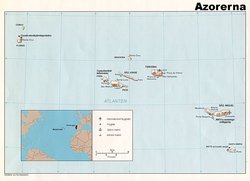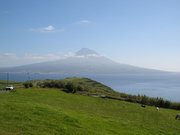Azores
|
|
Pt-acores.png
The Azores (Portuguese: Açores) are an archipelago of Portuguese islands in the middle of the Atlantic Ocean, about 1,500 km from Lisbon and about 3,900 km from the east coast of North America.
The nine Azorean Islands extend for more than 600 km, and lie in a northwest-southeast direction. The vast extension of the islands defines an immense exclusive economic zone (EEZ) of 1.1 million km². The westernmost point of this area is 3,380 km from the North American continent. Except for Santa Maria Island, all of the islands have volcanic origins. The mountain of Pico on Pico Island at 2,351 m in altitude, is the highest in all of Portugal. The Azores are actually the tops of the tallest mountains on the planet as measured from their base at the bottom of the ocean. The islands are an autonomous region of Portugal.
Though it is commonly said that the archipelago is named after the goshawk (Açor in Portuguese), because it was supposed to be a common bird at the time of the discovery, it actually never existed in the islands. The origin of the name is unknown. Some historians indicate the archaic portuguese word "azures" (the plural of blue) because of the colour of the islands when seen from afar. Most, however, insist that the name is derived from birds, pointing to a local subspecies of the buzzard (Buteo buteo) as the animal the first explorers erroneously identified as goshawks.
| Contents |
History
Azores_old_map.jpg
In 1427, one of the captains sailing for Henry the Navigator discovered the Azores, possibly Gonçalo Velho, but this is not certain. The colonization of the islands started in 1439 with people mainly from the continental provinces of Algarve and Alentejo, in the following centuries settlers from other European countries arrived. In 1583 Philip II of Spain as king of Portugal sent his combined Iberian fleet to clear the French traders from the Azores, decisively hanging his prisoners-of-war from the yardarms and contributing to the "Black Legend". The Azores were the last part of Portugal to resist Philip's reign over Portugal.
The 1820 civil war in Portugal, had strong repercussion in the Azores. In 1829, in Vila da Praia, the liberals won over the absolutists, making Terceira Island, the main headquarters of the new Portuguese regime, and where the Counsil of Regency (Conselho de Regência) of Mary II of Portugal was established.
Beginning in 1868, Portugal issued its stamps overprinted with "AÇORES" for use in the islands. Between 1892 and 1906, it also issued separate stamps for the three administrative districts of the time.
Angra consisted of Terceira, São Jorge, and Graciosa, with the capital at Angra do Heroismo on Terceira.
Horta consisted of Pico, Faial, Flores, and Corvo, with the capital at Horta on Faial.
Ponta Delgada consisted of São Miguel and Santa Maria, with the capital at Ponta Delgada on São Miguel.
From 1938 to 1978, the archipelago was divided into three districts, quite equivalent (except in area) to those in the Portuguese mainland. The division was quite arbitrary, and didn’t follow the natural island groups, rather reflecting the location of each district capital on the three main cities (neither of each on the western group).
In 1976 the Azores became an Autonomous Region (Região Autónoma dos Açores) and the Azorean districts (Angra, Horta, Ponta Delgada) were suppressed.
Politics
Since becoming a Portuguese Autonomous Region, the executive section of the local authority has been located in Ponta Delgada, the legislative in Horta and the judicial in Angra do Heroísmo. The President of the Azorean Autonomous Region is Carlos Cesar.
Municipalities
Pasture_fields_in_The_Azores.jpg
The Azores are divided into 19 municipalities (concelhos); each municipality is further divided into parishes (freguesias). The Azores have a total of 156 parishes.
There are also 5 cities: Ponta Delgada and Ribeira Grande on São Miguel Island; Angra do Heroísmo and Praia da Vitória on Terceira, and Horta on Faial.
Santa Maria
São Miguel
Terceira
Graciosa
São Jorge
PicoFaial
Flores
Corvo
Geography
| Azorean Islands by Size | |
|---|---|
| Island | Area(km²) |
| São Miguel Island | 759 |
| Pico Island | 446 |
| Terceira Island | 403 |
| São Jorge Island | 246 |
| Faial Island | 173 |
| Flores Island | 143 |
| Santa Maria Island | 97 |
| Graciosa Island | 62 |
| Corvo Island | 17 |
The archipelago is spread out in the area of the parallel that passes through Lisbon (39º, 43'/39º, 55' North Latitude), giving it a moderate climate, with mild annual oscillation. The Azores lie in the Palearctic ecozone, forming a unique biome among the world's Temperate broadleaf and mixed forests, with many endemic species of plants. The nine islands have a total area of 2,355 km². Their individual areas vary between 759 km² (São Miguel) and 17 km² (Corvo). Three islands (São Miguel, Pico and Terceira) are bigger in size than Malta (composed of three different islands), São Miguel Island alone being twice as big.
The nine islands are divided into three groups:
- The Eastern Group (Grupo Oriental) of São Miguel, Santa Maria and Formigas Islets
- The Central Group (Grupo Central) of Terceira, Graciosa, São Jorge, Pico and Faial
- The Western Group (Grupo Ocidental) of Flores and Corvo.
The islands were formed during the Tertiary period, in the Alpine phase. The volcanic origin of most islands is revealed by their volcanic cones and craters. Pico, a volcano that stands 2,351 metres high on the island of the same name, has the highest altitude in the Azores. The last vulcano to erupt was the Capelinhos Vulcano (Vulcão dos Capelinhos) in 1957, in western part of Faial island, increasing the size of that island. Santa Maria Island is the oldest Azorean island presenting several limestone and red clay extensions.
The Azores had a population of 238,767 in 31 December 2002 and a population density of 106 persons/km².
Demographics
| Azorean Islands by Population | |||
|---|---|---|---|
| Island | Population (2002) | Main City/Town | Municipalities |
| São Miguel Island | 130,154 | Ponta Delgada | 6 |
| Terceira Island | 54,996 | Angra do Heroísmo | 2 |
| Faial Island | 14,934 | Horta | 1 |
| Pico Island | 14,579 | Madalena | 3 |
| São Jorge Island | 9,522 | Velas | 2 |
| Santa Maria Island | 5,490 | Vila do Porto | 1 |
| Graciosa Island | 4,708 | Santa Cruz da Graciosa | 1 |
| Flores Island | 3,949 | Santa Cruz das Flores | 2 |
| Corvo Island | 435 | Vila do Corvo | 1 |
See also
External Links
- Azores Tourism Board (http://www.drtacores.pt/index2.html)ca:Açores
da:Açorerne de:Azoren et:Assoorid es:Azores eo:Acoroj fr:Açores ia:Azores id:Azores is:Asóreyjar he:האיים האזוריים lt:Azorai nl:Azoren ja:アゾレス諸島 no:Azorene pl:Azory pt:Açores ro:Azore sk:Azory fi:Azorit sv:Azorerna uk:Азорські острови


